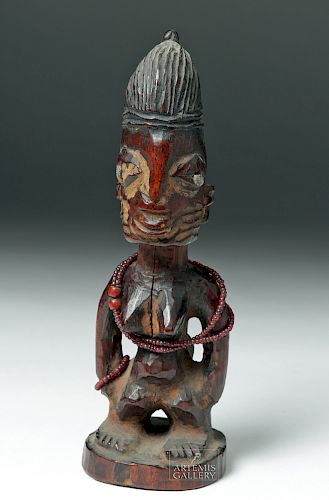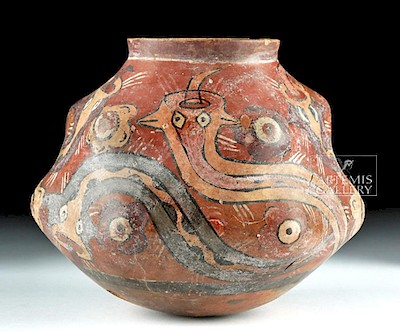Early 20th C. African Yoruban Wood Female Ibeji Figure
Lot 175
About Seller
Artemis Gallery
686 S Taylor Ave, Ste 106
Louisville, CO 80027
United States
Selling antiquities, ancient and ethnographic art online since 1993, Artemis Gallery specializes in Classical Antiquities (Egyptian, Greek, Roman, Near Eastern), Asian, Pre-Columbian, African / Tribal / Oceanographic art. Our extensive inventory includes pottery, stone, metal, wood, glass and textil...Read more
Categories
Estimate:
$600 - $900
Absentee vs Live bid
Two ways to bid:
- Leave a max absentee bid and the platform will bid on your behalf up to your maximum bid during the live auction.
- Bid live during the auction and your bids will be submitted real-time to the auctioneer.
Bid Increments
| Price | Bid Increment |
|---|---|
| $0 | $25 |
| $300 | $50 |
| $1,000 | $100 |
| $2,000 | $250 |
| $5,000 | $500 |
| $10,000 | $1,000 |
| $20,000 | $2,500 |
| $50,000 | $5,000 |
| $100,000 | $10,000 |
| $200,000 | $20,000 |
About Auction
By Artemis Gallery
Jul 5, 2018
Set Reminder
2018-07-05 10:00:00
2018-07-05 10:00:00
America/New_York
Bidsquare
Bidsquare : Ancient | Ethnographic | Fine Art
https://www.bidsquare.com/auctions/artemis-gallery/ancient-ethnographic-fine-art-3306
Featuring classical antiquities, ancient and ethnographic art from cultures encompassing the globe. Artemis Gallery info@artemisgallery.com
Featuring classical antiquities, ancient and ethnographic art from cultures encompassing the globe. Artemis Gallery info@artemisgallery.com
- Lot Description
West Africa, Nigeria, Yoruba peoples, ca. early to mid 20th century CE. A hand-carved wooden female "ere ibeji" figure, most likely from Oshogbo or the Igbomina region of Yorubaland (spanning Nigeria, Togo, and Benin), standing with both arms at her sides upon an integral base. She presents with large, pendulous breasts and delineated genitalia, rounded shoulders, an elongated face delineated with large bulging eyes and metal pupils, a wide, low-relief nose, cupped ears, and scarification marks on her cheeks, all crowned with a tall and elaborately-incised coiffure with remnants of its original indigo-blue pigment. Her body is also adorned with red cinnabar, and she is bedecked with three strands of beads around her neck and one arm. A wonderful example with nice patina from use and handling. Size: 9.625" H (24.4 cm).
The Yoruba have traditionally had a high rate of multiple births and have always valued twins as special. When one twin dies, a figure dedicated to Ibeji, the deity of twins, is carved to be the earthly abode of the spirit of that twin. The figure is then nurtured by the mother and/or the surviving twin. The Yoruba have one of the highest number of twin births in the world, four times higher than in Europe, for example. Ibeji are known to the Yoruba as two people who share one soul. If one of the human twins dies, whether as a child or an adult, the surviving human twin is considered to have little hope of living with only half a soul. Further, the deceased's soul must have a place to reside. Hence, a figure dedicated to Ibeji is carved to shelter the spirit of the deceased twin.
Provenance: private Eason Eige collection, Albuquerque, New Mexico, USA
All items legal to buy/sell under U.S. Statute covering cultural patrimony Code 2600, CHAPTER 14, and are guaranteed to be as described or your money back.
A Certificate of Authenticity will accompany all winning bids.
We ship worldwide and handle all shipping in-house for your convenience.
#131579Expected surface wear commensurate with age and use, stable hairline fissures along verso, chest, and face, fading to pigmentation, and small nicks to face and body, otherwise intact and very good. Nice patina and light earthen deposits throughout.Condition
- Shipping Info
-
All shipping is handled in-house for your convenience. Your invoice from Artemis Gallery will include shipping calculation instructions. If in doubt, please inquire BEFORE bidding for estimated shipping costs for individual items.
-
- Buyer's Premium



 EUR
EUR CAD
CAD AUD
AUD GBP
GBP MXN
MXN HKD
HKD CNY
CNY MYR
MYR SEK
SEK SGD
SGD CHF
CHF THB
THB

















